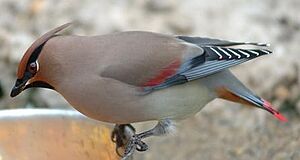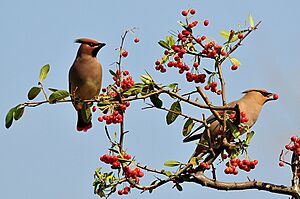Japanese waxwing facts for kids
Quick facts for kids Japanese waxwing |
|
|---|---|
 |
|
| Conservation status | |
| Scientific classification | |
| Genus: |
Bombycilla
|
| Species: |
japonica
|
The Japanese waxwing (Bombycilla japonica) is a beautiful bird that lives in East Asia. It is a type of passerine bird, which means it belongs to a large group of birds often called "perching birds." These birds are known for their ability to grip branches with their feet.
Japanese waxwings are part of the waxwing family. They mostly eat fruit and berries. But in the summer, they also enjoy eating insects. Their nests are shaped like cups. They build them in trees using small twigs, grass, and moss.
These birds get their name from their wing feathers. Some of these feathers have red tips. These tips look a bit like the red wax used for sealing wax.
Contents
What Does a Japanese Waxwing Look Like?
The Japanese waxwing is about 18 cm (about 7 inches) long. Its body is mostly a pretty pinkish-brown color.
This bird has a cool, pointed crest on its head. It also has a black throat and a black stripe that goes through its eye. Its belly is a pale yellow in the middle. The tail is black with a bright red tip.
The wings of the Japanese waxwing have a special pattern. They are black, grey, and white. There is also a reddish-brown stripe across them. When these birds call, they make a high-pitched trill sound. They do not have a true song like some other birds.
How is it Different from Other Waxwings?
Unlike some other waxwing species, the Japanese waxwing does not have waxy red tips on its wing feathers. This is a key difference.
Japanese waxwings often fly in groups with Bohemian waxwings. Bohemian waxwings are a bit bigger. They also have yellow tail-tips and a greyish belly. Plus, they do not have the reddish-brown stripe on their wings.
Where Do Japanese Waxwings Live?
Japanese waxwings breed in thick coniferous pine forests. These forests are found in the Russian Far East. This includes places like Amur, Manchuria, and Kamchatka. They also breed in Heilongjiang province in north-east China.
Sadly, these birds face some threats. Their favorite forest homes are being lost or damaged. This puts them at risk of extinction.
Where Do They Go in Winter?
When it's not breeding season, Japanese waxwings fly south for the winter. They spend the colder months in Japan, the Korean Peninsula, and Eastern China.
Their exact locations can change each year. This is because they travel to find food, especially seasonal berries. So, they might be common in one area one year and then move somewhere else the next.
In Japan, they are usually seen from November to April. Not many stay on Hokkaidō. But in south-western Japan, like parts of Kyūshū, Shikoku, and Honshu, you might see more Japanese waxwings than Bohemian waxwings.
During winter, they live in open woodlands, farmlands, or low mountains. They often visit parks and gardens. These places have lots of berry-filled trees for them to eat from.
Where Else Have They Been Seen?
Sometimes, Japanese waxwings are seen in places they usually do not visit. These are called vagrant birds. They have been spotted in Hong Kong, Central China, and Taiwan.
However, if a Japanese waxwing is seen very far away, like in Europe, South Asia, or the Middle East, it is probably an escapee. This means it likely got out of captivity (like from a bird collector) rather than being a truly wild bird.



